Shedding Light on Illuminated Manuscripts
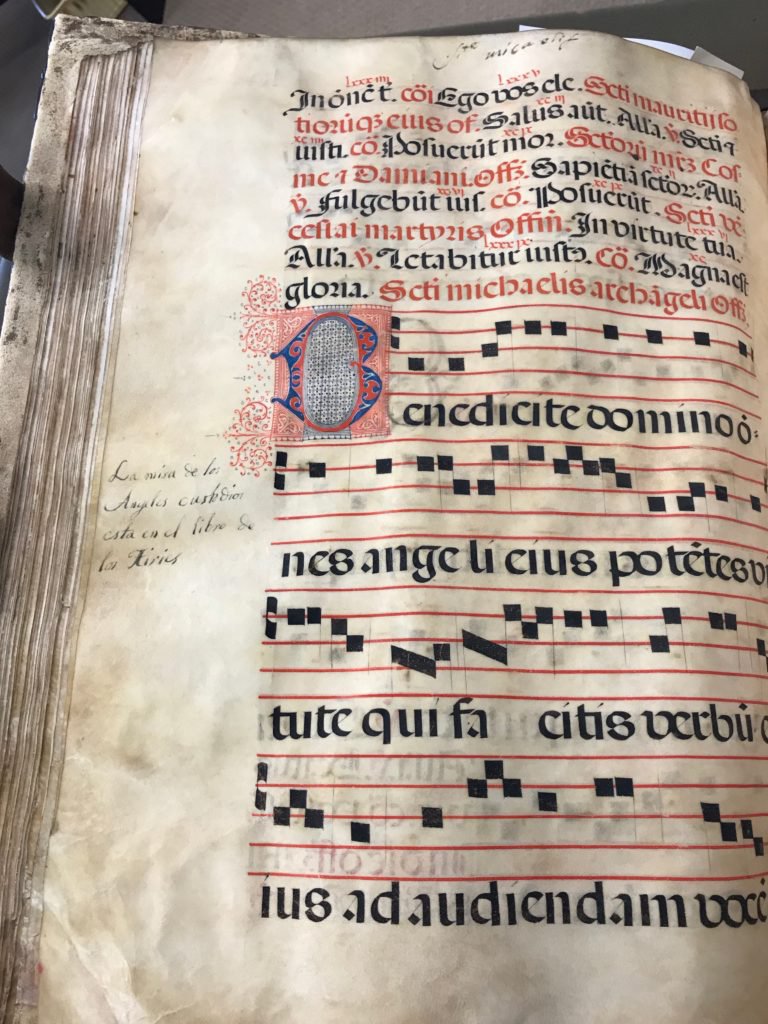
By Nora Ramsey, Reference Assistant
I work as a reference assistant in the Special Collections Research Center on the 6th floor of Bird Library. If you have ever met me, I talk a little too much about how much I love my job. As a reference assistant, I am able to help people from all around the world to explore our collections. By doing so, I am able to familiarize myself with the many interesting and unique collections within the SCRC. Being able to experience history in a multitude of different ways is the best part of my job. Most recently, I have been captivated by our collection of illuminated manuscripts.
Illuminated manuscripts are handwritten books that have been adorned with vibrant colors, artwork, and even gold. These embellishments sometimes include small and large illustrations, initials, borders, or other decorative elements. Initially, monasteries created illuminated manuscripts as tools for church services such as prayer books, hymnals and daily devotions. While many of these manuscripts are religious in nature, there are many different variations that can be used personally or practically. Books of Hours, for example, were personal books meant to inspire these devotions in daily life while antiphoners were practical books for music performance.
Manuscript books were created by and for the use of individuals and no two copies are exactly the same. Historians and librarians work from the physical pages themselves to fill in the blank spots of the book’s history. As a student working towards a career in special collections, I find that this is the most interesting part of working with manuscripts. History is embedded into the pages, and the fun lies in the mystery.
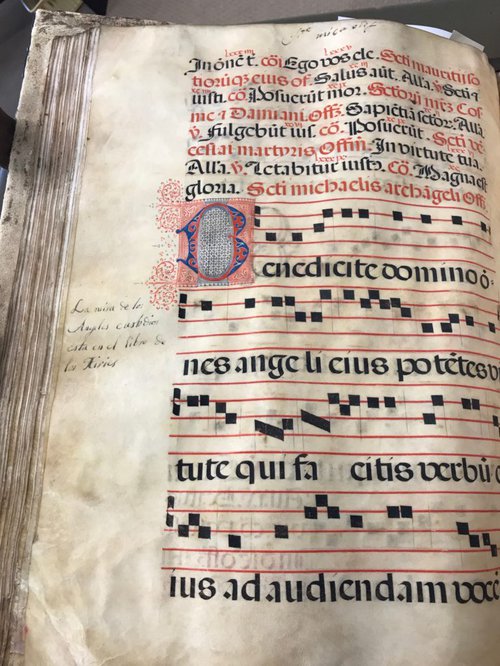
A page of music, text, and annotation from the Weiss Antiphoner.

Red, blue, and black floral and geometric designs on tan-colored vellum.
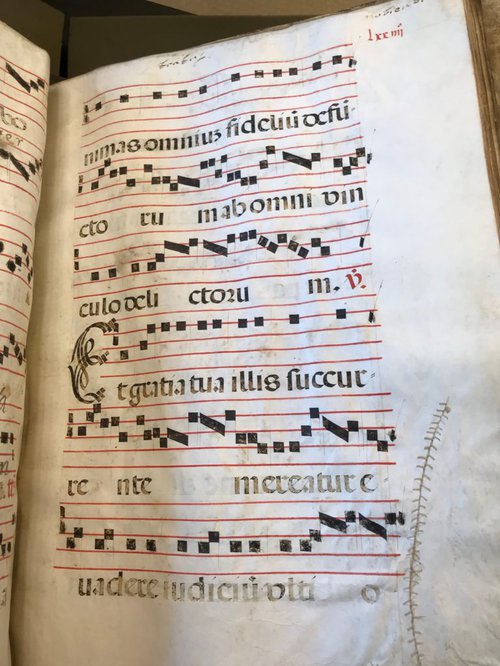
A page of the Antiphoner featuring a large repair on the lower right hand side of the page.
The Gradual of Saints, also known as the Weiss Antiphoner, contains liturgical music of the Church which consists of Gregorian chant or monophonic harmony. This music was used to accompany the text of the mass and the canonical hours. The codex is a surprisingly large and evidently well-loved Dominican Gradual of Saints which can be dated c. 1484-1524 most likely originating from Castile, Spain.
As a musician myself, it is extremely interesting to see early musical notation and how performers approached practice. The Antiphoner’s pages are well worn— evidence of many years of use. Unlike music used for entertainment in later eras like the Romantic Period, this use of music was used exclusively for Church services. Musicians either worked for the church or for the nobility; they did not create music to be consumed by the general public like today. The large and extensive repairs indicate that this text was important enough to preserve its functionality. Also indicative of its practical nature is the size of the original writing. This text can easily be seen from several feet away by a moderately sized choir. In addition to the original text, there are also many marginal notes from the various church musicians using the text. These notes exist in a variety of different handwriting and most often refer to the function of the music. Sometimes, the notes will extend or edit a line of music. Many times, the handwriting is concerned with “naming the saint, time of the calendar or liturgical year, a specific service connected to the chants on the page, and sometimes additional cross references to chants in other books” (Harden). These comments are almost exactly what I would write in my own music, although I doubt that mine will exist 500 years from now.
Although the manuscript was well used, the decoration of the text implies that it was also meant to be elegant— this is the Church we’re talking about after all. The illuminations consist of detailed and intricate designs in red and blue ink. While there are no miniatures, animals, floral designs or gold leaf, this manuscript was likely an expensive asset to the Church.
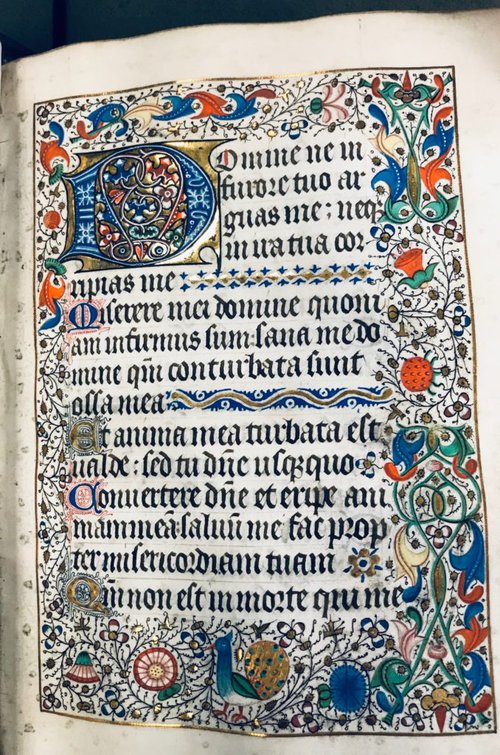
A page from Le Louchier Hours featuring elaborate decorations, including illuminated borders and gold leaf.
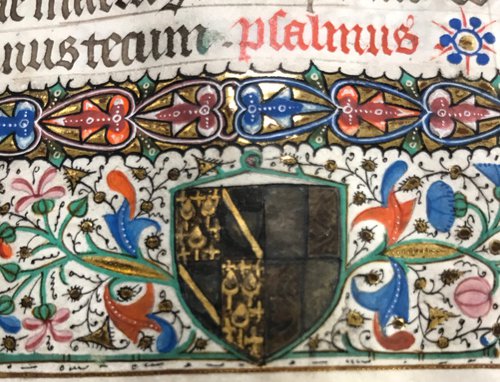
The crest belonging to Le Louchier-De Buillemont family which also incorporates the insignia for the Croquevilain family.
Comparatively, manuscripts commissioned by wealthy patrons instead of the Church stand out as more personal and remarkably embellished books. For example, within the collections at SCRC, Le Louchier Hours, otherwise known as The Syracuse Hours, is a great example of personalized details within commissioned manuscripts. The manuscript itself is relatively small, indicating this book could travel with its owner easily, unlike the Gradual of Saints where size was an important factor in its functionality. However, in a Book of Hours, a patron is able to tailor special supplemental devotions to themselves or their family. These books are more diverse in artwork, ranging from a few painted initials to gorgeous illuminated borders and full-page pictures. In manuscripts such as these, illuminators would pound gold into thin leaves that they would then use to decorate pages in the book. The gold leaf in the Le Louchier Hours is extremely evident; there are pieces of gold on almost every page and the book even has gilded edges. The Le Louchier Hours is truly a no-expense-spared codex, evident in the detailed marginalia and gold leaf within the artwork.
Personalized details in the book are also examples of the extravagance expected from wealthy patrons. This manuscript contains a crest belonging to the Le Louchier-De Buillemont family which also incorporates the insignia for the Croquevilain family. The combination of the crest and insignia imply the union of the families, so the book could have been created after the marriage of Robert Le Louchier (c.1407) and Anne Croquevilain of Tournai (b. ca.1416; d. 1503) in 1435. However, this conclusion is at most only speculation because we have no other sources other than the crest itself.
The creators of these beautiful books would never have predicted that these two books would ever be in the same room together. As a student at Syracuse University and an employee of SCRC, I count myself lucky that I get to experience these materials in such unique ways. If you are interested in materials such as these, I recommend visiting SCRC to see them yourself.
The Gradual of Saints (Weiss Antiphoner) and Book of Hours are part of our rare books collection (Special Collections Research Center, Syracuse University Libraries).
Additional Sources:
Stein, Wendy A. “The Book of Hours: A Medieval Bestseller.” In Heilbrunn Timeline of Art History. New York: The Metropolitan Museum of Art, 2000–. http://www.metmuseum.org/toah/hd/hour/hd_hour.htm. June 2017.
"Gregorian chant." Britannica Academic, Encyclopædia Britannica, 9 Mar. 2007. academic.eb.com/levels/collegiate/article/Gregorian-chant/38014. Accessed 11 Oct. 2019.
Harden, Jean. “The Weiss Antiphoner.” Paper for IST 509, History of Recorded Information, Syracuse University, July 17, 1990.
